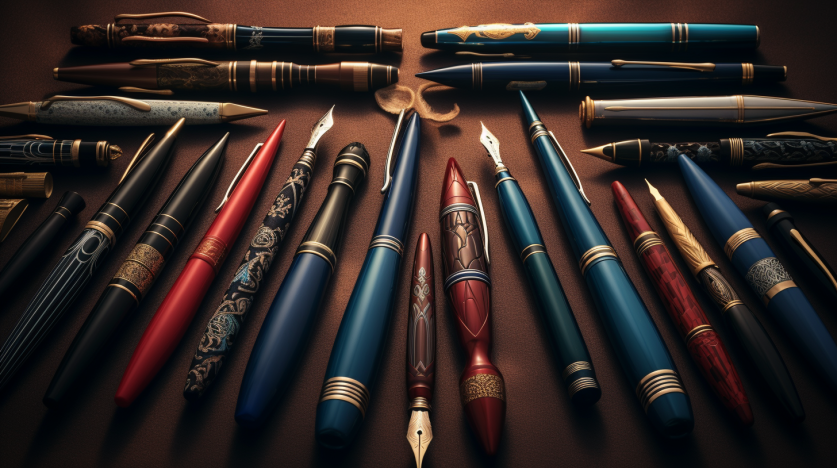Mastering the Art of Choosing Between Fountain and Roller Pens

Pens possess a peculiar power, they’re not just writing tools, they’re personal statements. I’m here to help you navigate the nuanced world of fountain and roller pens.
From understanding their unique features to weighing pros and cons, we’ll explore together. Whether you’re a pen aficionado or a curious beginner, I’ve got your back.
Let’s embark on this journey of mastering the art of choosing the perfect pen. It’s not just about writing, it’s about expressing your style.
Understanding the Basics of Pens
Before we delve into the differences between fountain and roller pens, it’s essential that I first explain the basic mechanics behind how a pen works. Essentially, a pen is a tool that delivers ink from a reservoir to a writing surface. The durability of a pen heavily relies on the construction of its reservoir, nib, and body.
When it comes to ink types, there are three main categories: dye-based, pigment-based, and iron gall. Dye-based inks are vibrant but tend to fade over time. Pigment-based inks are water-resistant and fade-proof, making them ideal for archival purposes. Iron gall ink, traditionally used in fountain pens, is water-resistant and has excellent longevity.
Understanding these basics will aid in choosing the right pen for your needs.
Features of Fountain Pens
Now, let’s check out the distinctive features of fountain pens that set them apart from their counterparts. The most prominent difference is their ink refilling techniques. Unlike roller pens, which use disposable cartridges, fountain pens can be refilled with bottled ink. This allows for a broad range of color choices, and it’s also eco-friendly. However, you need to be cautious during refills to prevent spills.
The nib, another key feature, can be maintained and replaced. Nib maintenance tips include cleaning it regularly with room-temperature water to avoid clogging. Never use hot water as it can warp the nib. Also, experts recommend not pressing too hard while writing to prolong the nib’s lifespan.
With careful use, a fountain pen can be a lifetime investment.
Roller Pens: A Detailed Insight
So, why would I choose a roller pen over a fountain pen?
Firstly, roller pens are simpler to handle. There’s no need for constant ink refills like with fountain pens. Roller Pen Maintenance is also a breeze – I just put in a new cartridge when the ink runs out. This greatly reduces the risk of ink spills, ensuring a cleaner writing experience.
Additionally, Customizing Roller Pens can be a fun hobby. You can play around with different colors and thicknesses, making it easy to find a pen that matches your style.
The roller pen’s consistency in ink flow also guarantees smooth, uninterrupted writing, unlike the occasional skips found in fountain pens.
Comparing Fountain and Roller Pens
In terms of ink longevity comparison, fountain pens typically last longer on a single fill, but roller pens offer the convenience of quickly replaceable cartridges. That’s something to consider if you’re going for longevity.
Next, let’s talk about writing comfort evaluation. The fountain pen, with its flexible nib, requires less pressure and offers a smoother writing experience. However, roller pens, with their consistent ink flow, provide a more predictable and uniform line, which some users might find more comfortable.
In essence, each pen type has its merits and drawbacks. Your choice will largely depend on what you value more: the longevity of fountain pens or the convenience and comfort of roller pens.
Top Brands for Each Pen Type
When it comes to top-notch fountain and roller pens, you’ll find several reputable brands in the market worth considering.
Let’s start with fountain pens. Montblanc, with its rich brand history exploration, is renowned for quality craftsmanship and superior ink longevity.
Pilot, another reputable brand, offers a range of high-quality pens with excellent ink longevity comparison.
For roller pens, you can’t go wrong with the smooth writing experience from Uni-ball. Parker, a name synonymous with luxury, offers roller pens that aren’t only stylish but also have a reputation for long-lasting ink.
Brands like Lamy and Cross also offer a blend of functionality and design in their roller pens. These brands have withstood the test of time and continue to be popular choices among pen aficionados.
Frequently Asked Questions
How Do I Properly Maintain and Clean a Fountain Pen?
I clean my fountain pen by first emptying the ink capacity. Then, I’ll thoroughly rinse the nib and if it’s damaged or worn out, I’ll replace it. Regular maintenance ensures optimal performance.
Are There Specific Types of Ink That Should Be Used With Roller Pens?
Yes, roller pens require specific inks. The ink’s viscosity and drying speed matter. High-viscosity ink flows smoothly, but slow-drying ink can smudge. I’d recommend quick-drying, medium-viscosity ink for a satisfying writing experience.
Can I Travel With a Fountain Pen Without It Leaking?
Sure, I can travel with a fountain pen without it leaking. I just ensure it’s stored upright and I’ve reduced its ink capacity. It’s one of my travel essentials, no leaks yet!
How Does the Writing Experience Differ Between Using a Roller Pen and a Fountain Pen?
In my experience, fountain pens offer more nib variety, which affects line thickness and ink flow. Roller pens, on the other hand, excel in pen ergonomics, providing consistent writing with less pressure needed.
Are There Eco-Friendly or Sustainable Options for Both Fountain and Roller Pens?
Yes, there are. I’ve found pens made from recycled materials. Also, fountain pens can be refilled with ink, reducing waste. Some roller pens even offer refillable cartridges, making them a sustainable choice too.
